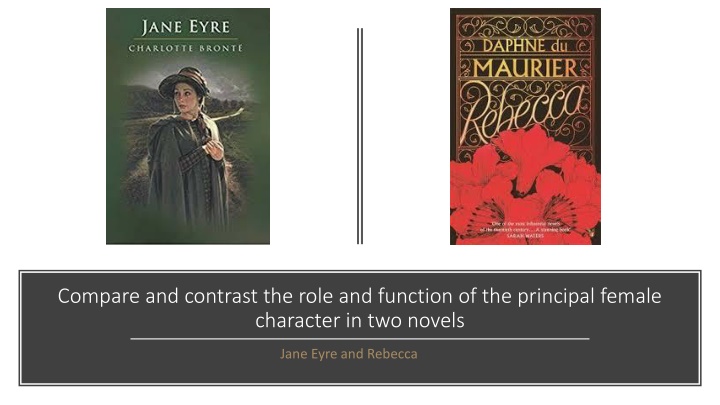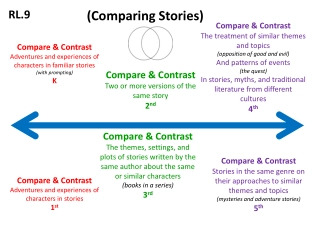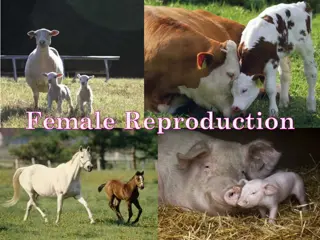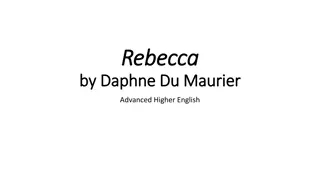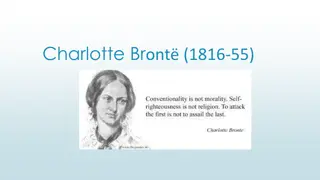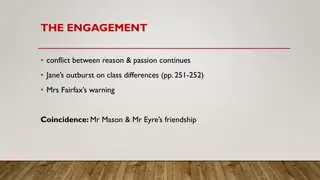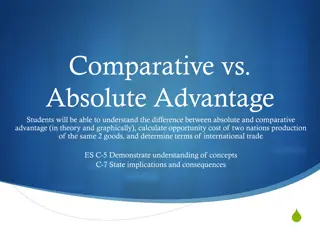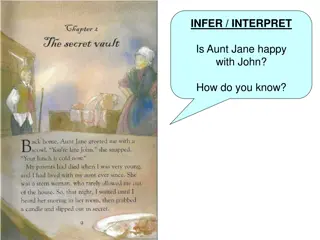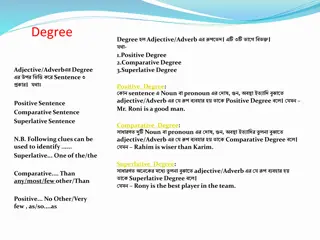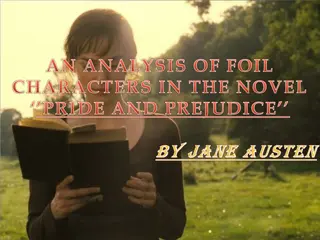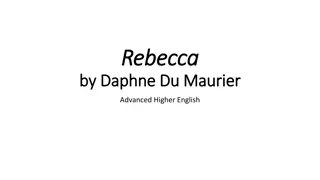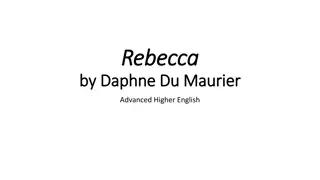A Comparative Analysis of Leading Female Characters in Jane Eyre and Rebecca
The principal female characters in Jane Eyre by Charlotte Bronte and Rebecca by Daphne du Maurier are analyzed in terms of their roles and functions within the novels, highlighting themes of gender equality, societal expectations, and individual identity struggles they face. Both characters, Jane and the unnamed narrator in Rebecca, navigate challenges related to power dynamics, marriage, and societal norms, reflecting the broader issues of women's roles in their respective societies.
Download Presentation

Please find below an Image/Link to download the presentation.
The content on the website is provided AS IS for your information and personal use only. It may not be sold, licensed, or shared on other websites without obtaining consent from the author.If you encounter any issues during the download, it is possible that the publisher has removed the file from their server.
You are allowed to download the files provided on this website for personal or commercial use, subject to the condition that they are used lawfully. All files are the property of their respective owners.
The content on the website is provided AS IS for your information and personal use only. It may not be sold, licensed, or shared on other websites without obtaining consent from the author.
E N D
Presentation Transcript
Compare and contrast the role and function of the principal female character in two novels Jane Eyre and Rebecca
Introduction The roles and functions of the leading female characters are discussed in Jane Eyre by Charlotte Bronte and Rebecca by Daphne du Maurier. The roles of women differ from their functions. The main function of a character in a story is to extend the plot or to make it more enjoyable, whereas the role is the type of character within the story which changes throughout the story. In Bronte s novel, Jane faces an uphill battle to become independent, but struggles when faced with a series of men who do not respect women as their equals; Mr Brocklehurt, Rochester and St. John. Bronte uses marriage to portray the struggle for power between both genders. Similarly, in Rebecca, our narrator struggles to find a position within society that is not linked to her new and wealthy husband Maxim. In some ways, Rebecca reflects the social mores of the early 20thcentury England and it critiques society s expectations about how women should behave. Both novels compare as our protagonist s struggle throughout for equality.
Jane Eyre In 19thcentury England, gender roles strongly influenced people s behaviour and identities. Women experienced condescending attitudes about a woman s place, their intelligence and voice. Bronte uses marriage within Jane Eyre to show readers the struggle for power and control between the genders. Jane attempts to stand up for women s equality throughout the novel, but does struggle because of gender roles. Even though Bertha Mason is insane, she is symbolic of how married women can be repressed and controlled. Jane fends off marriage proposals that would destroy her identity and fights for equality in her relationships.
Jane Eyre In chapter 32, Jane explains to readers when talking to St John; He had not imagined that a woman would dare to speak so to a man. For me, I felt at home in this sort of discourse. I could never rest in communication with strong, discreet, and refined minds, whether male or female. In this readers can see how Jane is passionate about female equality and how she feels comfortable about it. Also in chapter 14, Jane says I don t think, sir, you have a right to command me, merely because you are older than I, or because you have seen more of the world than I have; your claim to superiority depends on the use you have made of your time and experience to Rochester. This shows Jane s strength that she upholds, to stand up to a man for what she truly believes for herself and other women.
Jane Eyre, Critical Readings Discovering Literature: Romantics and Victorians While Bront does not approve of women voting, she does believe they should be allowed to work. In the novel, Jane makes a passionate plea for women to be allowed to use their talents, and not to be confined to the home making puddings and knitting stocking, playing on the piano and embroidering bags' (chaper 12). Crossref-it.info In general social terms, the novel does not ultimately challenge the status quo the present state of things: it points out religious hypocrisy and the abuse of wealth and privilege in relations to women, but does not argue for any fundamental change in the structure of society.
Rebecca In Rebecca , Daphne du Maurier also explores the idea of roles and functions for the principal female character. When it was published, about 75 years ago, assumptions about how women (especially married women) had to behave are completely different than they are today. The biggest challenge to a pro-feminist interpretation of Rebecca is Rebecca herself, the more readers learn about her, our impression of her becomes increasingly negative. Rebecca could be viewed as the villain. However, by modern standards, Rebecca doesn't seem so bad, as far as her duplicity and her affairs are concerned, she could be considered a victim of sexism of her era. If du Maurier agrees with Maxim that Rebecca is a villain, then Rebecca is a more simplistic novel overall, as well as badly dated in its treatment of gender roles. It judges Rebecca according to a set of rules for female behaviour that simply don t carry much currency anymore.
Rebecca The narrator s role as a women is similar to Rebecca in which a man has more power over her. She feels she is constantly being watched during her time at Manderley. Her smallest action is measured again a social standards for how proper ladies should behave. For readers, we never learn her real name only by Mrs De Winter (her husbands name) and she is forced to structure her new life around her husband s existence. Maxim can be seen as the villain instead of Rebecca as he is a controlling husband who expects the narrator to follow. This links to Bertha Mason from Jane Eyre as she could also be seen as either the hero or the villain in her own story.
Rebecca In chapter 11, the narrator says; Rebecca must have been a wonderful person. I could not believe that I had said the name at last I had said the name. I had said the word Rebecca aloud. It was a tremendous relief when talking about Rebecca. This shows the narrator s stress and anxiety that she has over Rebecca to even say her name out loud. It shows readers how different the narrator and Rebecca are and how powerful Rebecca truly was. Also, in chapter 16, Maxim says A husband is not so very different from a father after all. There is a certain type of knowledge I prefer you not to have don t ask me any more questions, or I shall put you in the corner this shows readers just the control and authority that Maxim believes he can hold over his own wife.
Rebecca, Critical Readings My Real Rebecca FSG Work in Progress As the story progresses, it becomes increasingly obvious just how trapped both the former and current Mrs de Winters have been. The atmosphere of our narrator s new life is enclosed and claustrophobic. The house, of which she isn t even shown half, is devoid of any of her possessions, the driveway is over-long and dark, the gardens are full and wooded and the servants unfriendly. When she walks the grounds, she is overpowered with the heady scent of towering azaleas, which leads her to the ominously named Happy Valley, and then on to a treacherous bay.
Jane Eyre and Rebecca In comparison, the leading female characters are overshadowed by their male partners throughout the novel. In both, Bertha Mason and Rebecca are characters who have lost their fight for equality against their male partner, allowing their complete control over them. This shows readers how strong the male characters are against the female ones. However, in contrast, Jane strives for equality in her relationships whereas in Rebecca, our narrator allows male characters to have power and control over her. Readers learn that Rebecca attempted to stand up for more equality and control over Maxim in their marriage, but that ended with him killing her, showing his complete power and control that he aspires to have over women.
Conclusion In conclusion, the role and function of female characters within Jane Eyre and Rebecca are heightened although they compare in the fact that the similar ideas are expressed. This also shows the difference between their roles and functions, how Jane s passion continues throughout and the narrator doesn't put up a fight. They contrast in how the female character reacts to their intended role. In Jane Eyre, our female protagonist is desperate for equality within her relationships. However, in Rebecca the narrator suffers from the control and power that the male has over her. In comparison, the characters Jane and Rebecca are similar in how they fight for equality, but because of the timing in their society they are ruined as the male characters take control.
